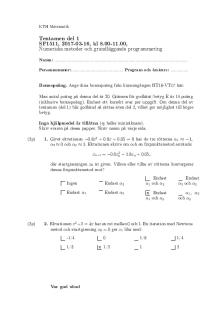ASTR110 Mars HW - Prof. Richard Wainscoat PDF

| Title | ASTR110 Mars HW - Prof. Richard Wainscoat |
|---|---|
| Course | Survey of Astronomy |
| Institution | University of Hawaii at Manoa |
| Pages | 2 |
| File Size | 39.6 KB |
| File Type | |
| Total Views | 131 |
Summary
Prof. Richard Wainscoat...
Description
Diamond Borges ASTR 110 10/30 Mars Homework 1. (5 points) Research at least two successful missions to Mars Pathfinder and Spirit & Opportunity a. Provide a short summary of these missions (2 points). Pathfinder: -1st rover on mars -launched dec. 1996, landed jul. 1997 -ended in sept. 1997 -designed to demo low cost technology to get a rover to Mars. -had instruments to analyze Mars atmosphere, climate, geology, and composition of rocks. -sent over 17,000 images Spirit & Opportunity -launched jun. & jul. 2003, landed 2004 -planned for a short run of 90 days -spirit ended in 2010, but opportunity is still working -they were both planned to look at the surface for evidence of past water activity on Mars. b. Explain three discoveries that were made by these missions (3 points). Pathfinder: -sent data on water features & chemical composition of rocks & soil. This info suggested that Mars was once wet. Spirit: -discovered how Mars was shaped due to impacts, volcanic eruptions, and subsurface water Opportunity: -found evidence of past lakes that could of had microbial life.
2. (3 points) Watch the movie “The Martian.” If you have already seen it, and think that you recall it well enough, you don’t need to watch it again. a. List two items that the filmmakers portrayed that were realistic, and explain (2 points). Sky color: Mars has no atmosphere which means a dull color sky (almost orange) and The
Martian portrays that well. Tornadoes: In the movie, there are tornadoes on Mars. This is true and it can happen. Spirit had a recording one happening on the surface in 2005 b. List one item that the filmmakers portrayed that was not realistic, and explain (1 point). The dust storm that almost everyone knows, is not realistic. The dust storm would not be as strong in reality. If there are 100 mph winds on Mars, it is equivalent to 10 mph winds on Earth, therefore resulting in very weak (if any) dust storms. 3. (2 points) Research two unsuccessful missions to Mars. Explain why each of them failed. Mars Climate Orbiter: due to miscalculation of metric units and America’s units, the orbiter got too close to Mars and crashed. Mars Polar Lander: was supposed to land near the south pole, but it had to turn its antenna away from Earth in preparation for entering the atmosphere and it lost contact after that. Further investigation suggests that the software system was faulty and caused the retro rockets to turn off early, resulting in a crash of the lander. Two probes attached to the lander were set to release just after entering Mars atmosphere, but no signal was received from them....
Similar Free PDFs

Mars manual (Ensamblador)
- 14 Pages

Examen Mars 2011, questions
- 3 Pages

Cadbury vs. Mars differences
- 2 Pages

Examen Mars 2017, questions
- 3 Pages

Recommendation - Nakakaloka mars
- 1 Pages

Examen 2 Mars 2021, questions
- 1 Pages

MIDTERM 4 Mars 2018, réponses
- 14 Pages

Razones para odiarla - Emma Mars
- 55 Pages

Lab7 Google Mars Activity 18
- 9 Pages

Tenta 16 Mars 2017, svar
- 4 Pages

Richard- Kuklinski-pdf
- 15 Pages

HW 12 - HW 12
- 3 Pages
Popular Institutions
- Tinajero National High School - Annex
- Politeknik Caltex Riau
- Yokohama City University
- SGT University
- University of Al-Qadisiyah
- Divine Word College of Vigan
- Techniek College Rotterdam
- Universidade de Santiago
- Universiti Teknologi MARA Cawangan Johor Kampus Pasir Gudang
- Poltekkes Kemenkes Yogyakarta
- Baguio City National High School
- Colegio san marcos
- preparatoria uno
- Centro de Bachillerato Tecnológico Industrial y de Servicios No. 107
- Dalian Maritime University
- Quang Trung Secondary School
- Colegio Tecnológico en Informática
- Corporación Regional de Educación Superior
- Grupo CEDVA
- Dar Al Uloom University
- Centro de Estudios Preuniversitarios de la Universidad Nacional de Ingeniería
- 上智大学
- Aakash International School, Nuna Majara
- San Felipe Neri Catholic School
- Kang Chiao International School - New Taipei City
- Misamis Occidental National High School
- Institución Educativa Escuela Normal Juan Ladrilleros
- Kolehiyo ng Pantukan
- Batanes State College
- Instituto Continental
- Sekolah Menengah Kejuruan Kesehatan Kaltara (Tarakan)
- Colegio de La Inmaculada Concepcion - Cebu



